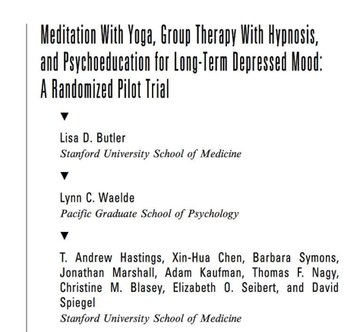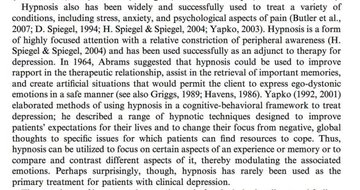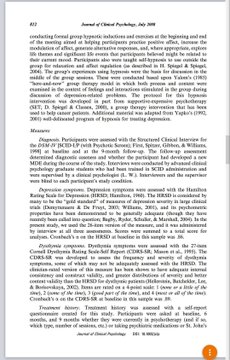While the paper by Ford and several other co-authors focused on whether various therapeutic techniques, including hypnosis, alleviate depression, it also discussed the therapeutic use of hypnosis to “assist in the retrieval of important memories” and to “create artificial situations” to assist in treatment.
Ford’s paper cited a controversial 1964 paper on the use of hypnosis to treat alcoholics and claimed that “hypnosis could be used to improve rapport in the therapeutic relationship, assist in the retrieval of important memories, and create artificial situations that would permit the client to express ego-dystonic emotions in a safe manner.” The study by Ford and her co-authors also used “self-hypnosis” to help treat their randomized sample of patients.
“Participants also were taught self-hypnosis to use outside the group for relaxation and affect regulation (as described in H. Spiegel & Spiegel, 2004),” the researchers explained. “The group’s experiences using hypnosis were the basis for discussion in the middle of the group sessions.”
The 2004 text by Spiegel and Spiegel referenced by Ford and her fellow researchers discusses in detail the use of hypnotism, and even self-hypnotism, to recover memories from traumatic episodes.
“Remember that all hypnosis is really self-hypnosis,” the authors of the referenced 2004 text on hypnotism wrote. “[T]herefore, therapists are only tapping into their patients’ natural ability to enter trance state.”
The authors noted that hypnosis as a means of recovering traumatic memories could also lead to the “contamination” of those memories.
“Patients are highly suggestible and easily subject to memory contamination,” they noted.
It is not known whether Ford underwent hypnotic therapy regarding her alleged assault, as she and her attorneys have refused to provide detailed notes from her therapists to the Senate despite providing portions to reporters for the Washington Post. Ford testified under oath that Kavanaugh’s name appears nowhere in her therapists’ notes.
Rachel Mitchell, the Arizona sex-crimes prosecutor who questioned Ford during her testimony before the Senate Judiciary Committee last Thursday, noted in her official report on Ford’s testimony that Ford’s ever-changing story was likely affected by the behavior of Ford’s attorneys, as well as the Democratic lawmakers and their staffs who interacted with Ford prior to her testimony.
Mitchell noted that Ford’s story seemed to change with each telling. In a July 6 text to the Washington Post, Ford claimed she was assaulted in the “mid 1980s.” That changed to the “early 80s” in a July 30 letter to Sen. Dianne Feinstein (D-Calif.). Similarly, she claimed that the assault happened to her in her “late teens,” before claiming that it happened when she was...Read More HERE




No comments:
Post a Comment
Test Word Verification